Armenia is a small landlocked mountainous country at the southern end of the Eurasian Caucasus. The Eurasian Caucasus consists of Russia, Georgia, Azerbaijan and Armenia. For those of us, including me, who were not really sure where to find Armenia, picture this: Russia and Georgia are to the north; Iran is to the south; Turkey is west and the Black Sea beyond. Azerbaijan is on the Eastern border and the Caspian Sea further east. As to the Caucasus, that’s a mountainous region between Europe and Asia lying between the Black Sea (west) and the Caspian Sea (east). Now that we know where it is, let’s start our adventure by zooming in on one of the most famous sights in all of Armenia – Mount Ararat.
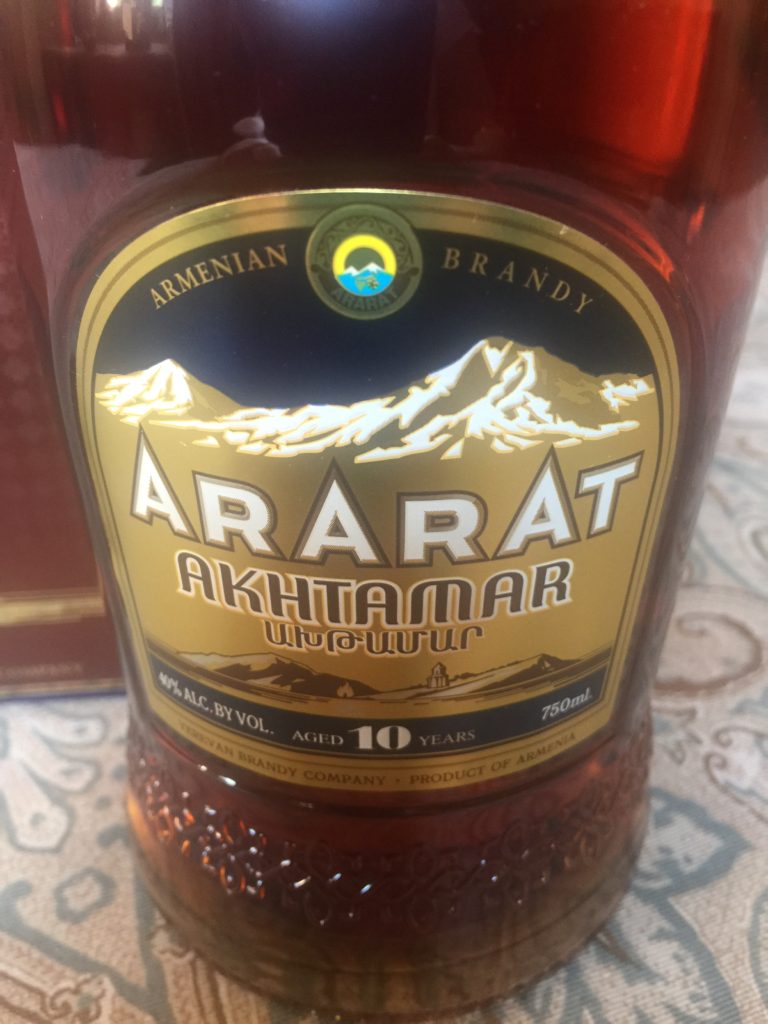
Mount Ararat is a dormant volcano reaching almost 17,000 feet up in the air at its highest point. Ararat isn’t even in Armenia. It is actually located in extreme eastern Turkey. The mountain has been called Ararat since the Middle Ages and is considered by many as the resting place of Noah’s Ark even though the Bible does not specifically refer to a Mt. Ararat, but rather the mountainous region of the land of Ararat. The mountain may be physically located in Turkey, but it is a national symbol of Armenia where it is considered to be sacred. In fact it is depicted on the Armenian coat of arms along with Noah’s Ark and is known as the “holy mountain” of the Armenian people. Armenia was the first Christian kingdom in the world.
The border with Turkey is quite controversial especially since many Armenians once lived in the land west of Ararat which used to be part of their homeland, and is now part of Turkey. If they want to see Mount Ararat, sadly they have to look at it from far away. Luckily you can see it from many houses in Yerevan, the capital of Armenia, as well as settlements in the Ararat plain. Greater Ararat and Little Ararat make up the two distinct cones of this famous volcano that last erupted in 1840 killing up to 10,000 people in the region. Relations between Turkey and Armenia are at best non-existent and the border between the two countries remains closed. Armenians will have to continue looking at Mount Ararat from afar. The Armenian border with Azerbaijan is also closed due to an on-going conflict ever since the Nagorno-Karabakh War of the 1990s, an ethnic territorial conflict between the Armenians living in that region and the Republic of Azerbaijan. To this day, Nagorno-Karabakh is in legal limbo claiming to be the independent Republic of Artsakh but still unrecognized as such.
Just like many countries in this part of the world, Armenia’s borders have been arbitrary and often changed depending upon whose rule they were currently under: Byzantine, Turks or Soviet Union among others. The most current situation has left them as the Republic of Armenia as they officially declared their independence from the Soviet Union on September 21, 1991.
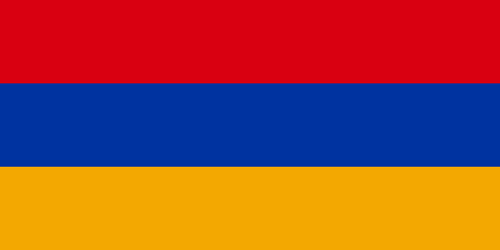
An estimated 3 million people now live in Armenia with a little over 1 million of them living in Yerevan; however so many Armenians have left their homeland through the years, that there are more of them living abroad than at home.
Back to their roots
Armenians have been making wine since ancient days with roots as far back as 401-400 BC when Greek armies passed that way and were supposedly presented with wine and beer. The wine and beer was made and stored in “karases”, the famous clay pots of Armenia. Archaeological excavations of the 19th and 20th centuries confirmed the Yerevan of today was a wine-making center back in the 9th century BC. Wine storehouses were also found with 480 karases in the Teshebaini fortress of Yerevan. Supposedly a karas could hold up to 37,000 daL (or dekaliter), and a dekaliter equals about 2.64 gallons of wine. According to my math, that’s over 97,000 gallons! 200 karases were also found in a total of 10 wine storehouses in several other sites.
The little Republic of Armenia at one time was so big it covered the eastern part of what is now the country of Turkey and a large part of the Caucasus Mountains. The now tiny 29,700 square kilometers currently known as Armenia are about the size of the Hawaiian Islands or the State of Maryland. It has cold winters, dry hot summers and volcanic soil. Vineyards in this mountainous country are at very high altitudes ranging from 1,600 to 5,000 feet. Many are over 5,000 above sea level. The climate in most vineyard areas is dry and continental with deserts to the south and more extensive plains to the north, and Armenian grapes seem to love it adapting well to their growing conditions. Grape vines are indigenous in Armenia. Petrified grape matter has shown that grape vines of a Vitis Vinifera species have grown there for many many years.
A major announcement came in 2011 that really brought Armenia into the forefront of wine world news when archaeologists claimed the discovery of the world’s oldest known wine production facility – the now world famous “Areni-1 cave”. The Areni cliffside cave complex is located near the mountain town of Areni in the Vayots Dzor region, and the Areni-1 provided evidence of winemaking activity dating back over 6,000 years. In addition to the earliest known shoe and the oldest known brain tissue from the Old World, they found a shallow basin used to press grapes, a storage vat, fermentation jars, grape seeds, remains of pressed grapes and dozens of dried vines. The grape seeds were from the Vitis vinifera variety, which is still used for making wine today. This places winemaking at about 4000 BC which is 900 years before the earliest similar wine making remains that were found in Egyptian tombs. Armenia’s neighbor, the Republic of Georgia also claims to be the seat of viticulture, but since Armenia displays evidence of early grape growing and winemaking, maybe they will share that distinction.
There are 17,000 hectares (42,000 acres) of vineyards in Armenia with an annual wine production of about 7.5 million liters (2 million US gallons) in 2016. Once known for its sherry and brandy production, there is now a small wine industry on the rise. With a fairly recent independence and lots of old technology still in use, there has been a recent modernization of the wine industry. There are some exciting new methods of winemaking and production. And like so many other industries, what was once old has now been rediscovered. For example, some modern producers are “rediscovering” how to use the old traditional techniques like the use of “karasi” clay jars.
Winemaking in Armenia: then and now
Winemaking is really ancient news in Armenia. After all, we now know that people have been making wine here for over 6,100 years. Armenia is considered the cradle of winemaking.
It is also another one of those countries that was snatched up by the Soviet Union and “requested” to move toward mass winemaking and distillation of alcoholic beverages. The communists confiscated all of the wineries, destroyed a lot of the vines and had no interest in winemaking techniques other than to make sweet wines and brandy. The production of sherry-type wines was very significant in Armenia and other former USSR regions. Armenian sherry wines were made from the Voskehat and Chilar indigenous grape varieties. Quality was never a consideration during all of this time although Armenian sherry was considered to be high quality. Independence finally came along for Armenia in 1991 and since then, the wine industry is being revived by people who are once again interested in quality. It is this interest and trend within the wine industry to rediscover the oldest wine producing countries in the world that has been making Armenian wine a rising star in the last decade. A number of Armenians living around the world are also bringing their money back home to invest in Armenian vineyards along with all of their business and marketing skills….. plus connections! And they can afford some of the best consultants around. It doesn’t hurt their cause any that the government has now been pushing to help winemakers market Armenia as a “Sacred Land of Wine”.
High profile winemakers from around the world seem to welcome the challenge to make wine in “undiscovered” wine countries/regions. As we previously mentioned, many of these regions have been making wine for thousands of years. They just haven’t been in the wine spotlight ………..until now.
Michel Rolland (Bordeaux, France) has been working with Karas Winery in Armavir. Rolland is dubbed a “flying winemaker” consultant, and has worked with more than 150 wineries on four continents including Ornellaia in Italy, Lapostolle in Chile and Harlan in Napa Valley.
Paul Hobbs (California, USA) is not only well known for his vineyard and winemaking skills in California and the Finger Lakes of New York, but his international vision for winemaking in Mendoza, Argentina; Cahors, France; Galicia, Spain and now the Yacoubian-Hobbs winery in Armenia where he is a partner.
Alberto Antonini (Tuscany, Italy) once the head winemaker for Antinori, consults for Zorah Wines. Antonini’s credits include numerous wineries in Italy, plus Argentina and Chile, California, Spain, South Africa, Romania and now Armenia.
If you need and are willing to take their advice, you have some A+ winemaking knowledge in these three!
KARAS WINERY
Case in point, Karas is a newly established winery compared to the rest of the country. Karas is in the Ararat Valley between Mount Aragats and Mount Ararat in the West of Armavir Region. Armavir is the smallest but the most heavily populated region in Armenia. Karas is the Armenian word for “amphora”, the vessel used in classical times to store wine.
Armavir is in the middle of thriving agricultural development, but also has a large tourist industry. The historical and cultural legacy of Armavir boasts such well-known sites as the Sardarapat Battle Memorial which is the religious and spiritual center of the Armenian Apostolic Church: the Holy City of Echmiadzin. This location had several major plusses for the Karas location: 1) mineral rich land suitable for making great wine, and 2) the innovation and technology already happening in this region.
The family that owns Karas left Armenia long ago as part of the diaspora, choosing to live in Argentina. Karas Winery is owned and managed by the Armenian-Argentinian uncle and niece Eduardo Eurnekian and Juliana Del Aguila Eurnekian who returned to their native Armenia fifteen years ago, bought these nine square miles of land and transformed 1,000 acres of it into vineyards. It took them three years just to remove the rocks from the land. The Eurnekians also own a premium vineyard property Bodega Del Fin Del Mundo in Neuquén, Patagonia Argentina where they have been making wine for more than a decade. Now they are also making wine sustainably using old family tradition and their modern expertise as Mount Ararat watches over them. They grow international and local whites and reds including Chardonnay, Colombard, Viognier, Areni, Khndoghni and Syrah.
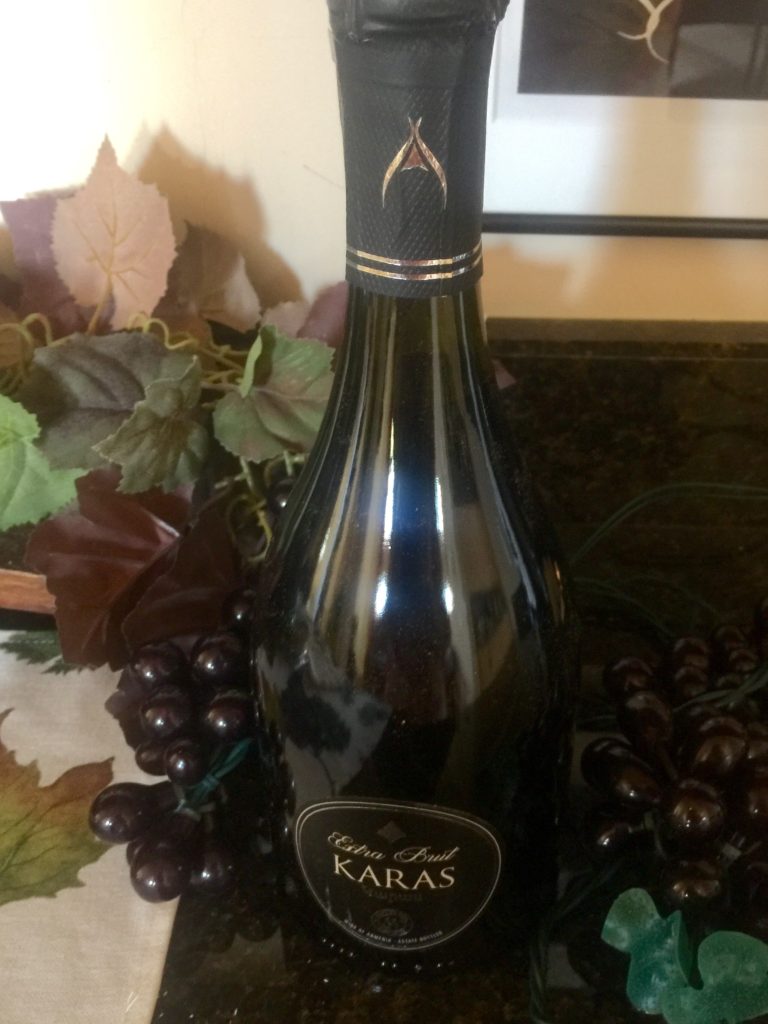
Karas Extra Brut Sparkling NV, Armavir, Armenia
Karas Sparkling is generally made from a blend of Colombard, Folle Blanche and Kangun however the sparkling we recently were able to purchase is made from 100% Rkatsiteli according to the label. Technical notes tell us it has a light yellow color with delicate and elegant bubbles displaying citric and fresh aromas with some notes of toast bread. Grapes are hand harvested, pressed and decanted for 24 hours, then fermented at 14-16 degrees C for 20 days. The second fermentation takes place in special pressure tanks for 30 days. Alcohol content is 12%. We have previously tasted and enjoyed Rkatsiteli, so are looking forward to these bubbles.
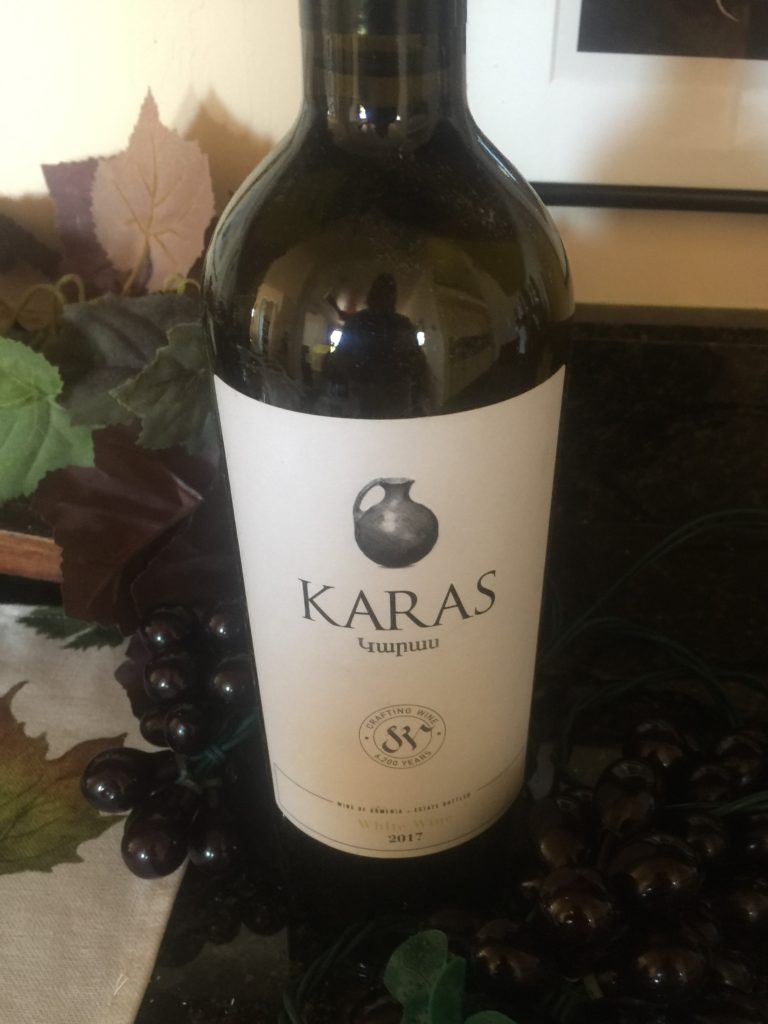
2017 Karas Classic White, Armavir, Armenia
The Karas white is a blend of 50% Kangun, 40% Chardonnay and 20% Viognier and 14% alcohol content. It should be yellow in the glass with subtle shades of green, aromas of pear, peach and pineapple; floral and spicy in the mouth with a fairly long finish.
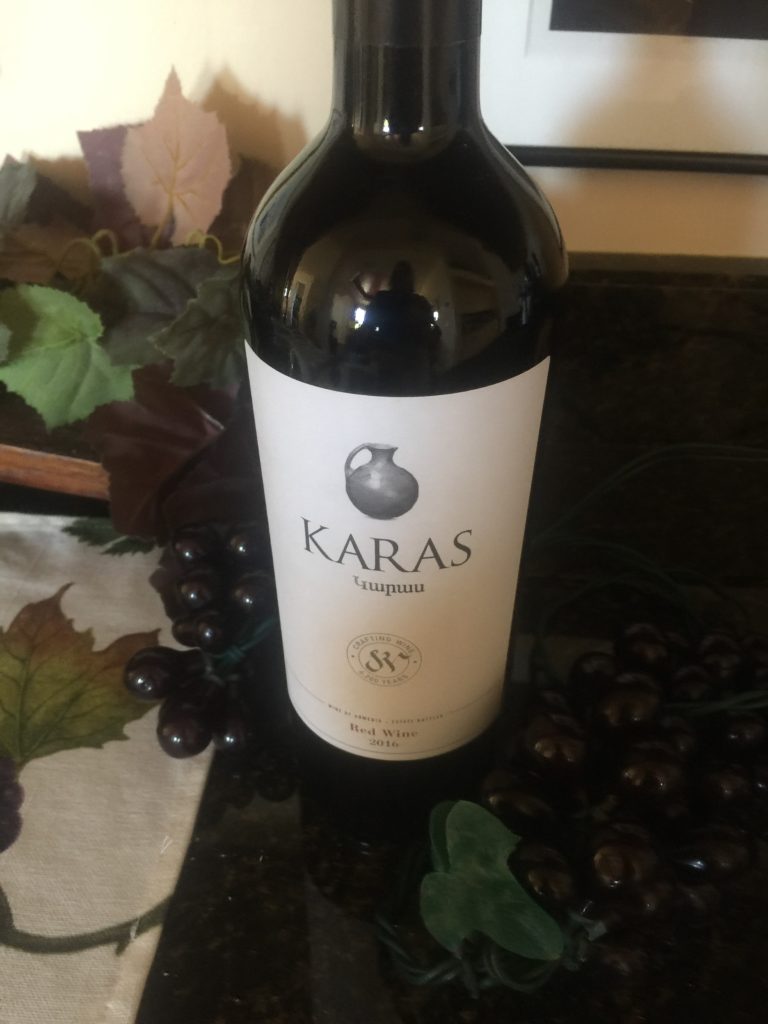
2016 Karas Classic Dry Red, Armavir, Armenia
The Karas red is an interesting blend of 35% Syrah, 35% Cot (Malbec), 20% Cabernet Franc and 10% Tannat. Grapes are hand harvested then go through cold maceration followed by fermentation at 26-28 degrees C for 20 days. Malolactic fermentation is done in tanks. It’s an elegant wine with good acidity, sweet tannins, fruity aromas and great acidity making it elegant and easy to drink. Alcohol is also 14%.
ZORAH WINES
Zorik Gharibian had a successful career in the Milan, Italy fashion industry before he decided to go back to Armenia and make wine. He and his wife began Zorah Wines in the village of Rind in the Areni region in 1998 with the goals of making wine from native grapes, aging it in amphorae and having the credentials of high powered winemaking consultants. Their vineyards are in an excellent wine region at an altitude of 4500 feet above sea level with a mix of volcanic and sedimentary rock, sandy soil rich in limestone to provide excellent drainage and no need for grafting as the area is phylloxerra-free. The cuttings of the vines come from ancient abandoned vineyards of a nearby 13th century monastery. Wines are aged in temperature controlled rough concrete vats and fermented with indigenous yeast. Then the wines are aged for around 12 months in the karas of varying sizes – some are buried in the ground while others are above the ground each giving a unique quality to the wine. After light filtration, the wine is bottle aged for about 6 months. Zorah Wines are highly acclaimed. The Karasi Areni Noir retails for at least $35 a bottle.
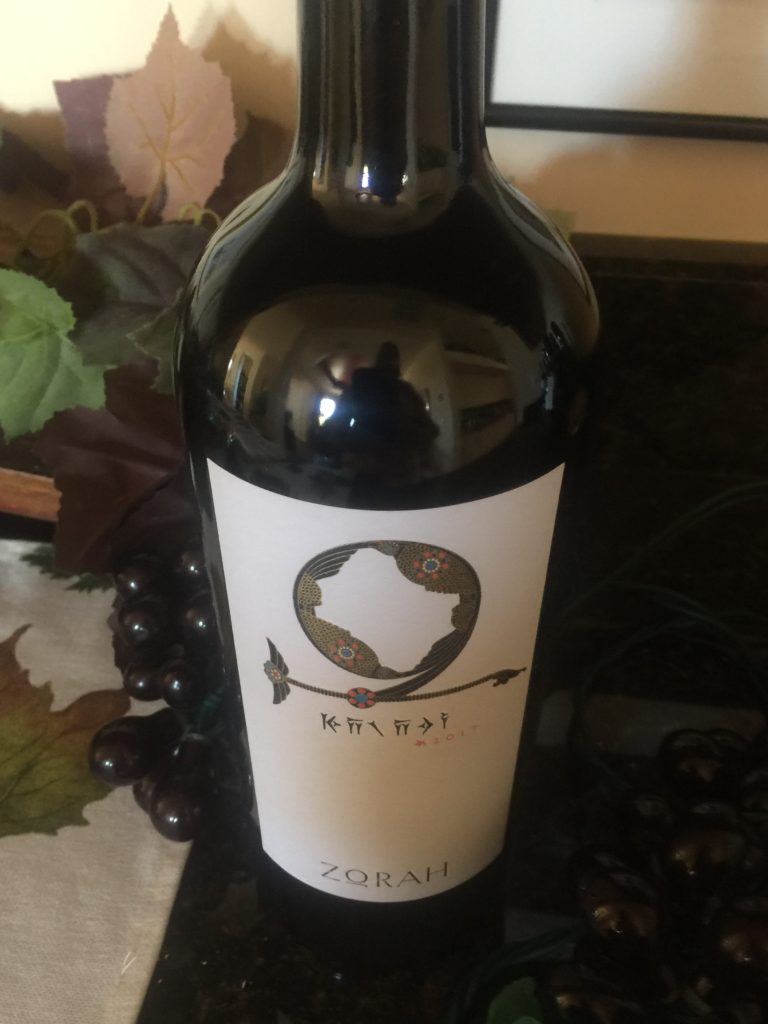
2017 Zorah Karasi Areni Noir, Vayots Dzor, Armenia
Zorah Karasi Areni wine has been aged in the traditional large, clay amphorae (karasi) for around 12 months. Their Karasi wines are a tribute to the ancient winemaking traditions of their ancestors. The wine is 100% Areni grapes that were grown at 1400 meters a.s.l. in a sandy soil, rich in limestone and large stones. The result should be bright ruby red in color with complex aromas of red fruits, lightly spiced with an elegant toasted note on the nose. It is expected to be full bodied and well balanced with silky ripe tannins. The alcohol level is 13.5%.
YACOUBIAN-HOBBS
Viken Yacoubian so enjoyed drinking a Pinot Noir in 2003 made by Paul Hobbs that he sent him an email. To his surprise, Paul replied which led to the 2005 exploration of Armenian winemaking regions by Paul and the Yacoubian brothers. They officially became partners in 2008 and the Yacoubian-Hobbs wine making venture was born. They settled on the Vayots Dzor region almost right across from the Areni-1 cave. Their vineyards are 1200 meters high in the rocky volcanic and limestone soils where they grow and produce their world-famous wines. The dry white wine is a blend of 80% Voskehat, 10% Khatuni, 5 % Qrdi and 5% Garan Demak (or “sheep’s tail”) from grapes in Aghavnadzor. Areni (100%) wines are sourced from vineyards in Rind, aged in French oak and produced in very small case lots. The “Sarpina” is named for the posts used to train the vines which is recorded in Armenian agricultural history books.
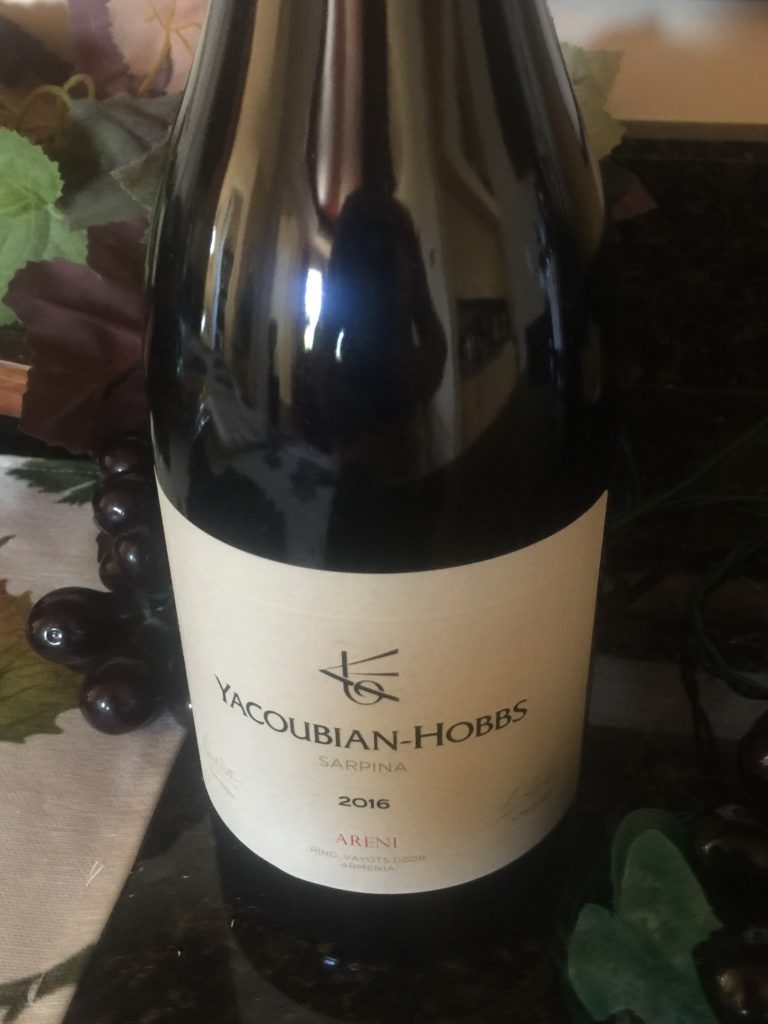
2016 Yacoubian-Hobbs “Sarpina” Areni, Rind, Vayots Dzor, Armenia
From 100% Areni grapes grown in volcanic soil 4000 feet high just a short distance from the Areni-1 cave; fermented in stainless steel and aged 7 months in French oak barrels. The winemaker flavor profile: “A complex wine with intense aromatics of ripe red cherries, black plum and dried flowers, followed by nuances of vanilla, cinnamon and chocolate. On the palate, elegant flavors….velvety tannins create full, round mouthfeel with complexity and intensity that lingers on the finish.”
Armenia’s wine-growing regions and grapes:
Regions
Armenia is divided into ten provinces with the city of Yerevan as the country’s capital. An estimated 3 million people live in Armenia with a little over 1 million of them living in Yerevan. The economy was mostly industry-based and highly dependent on outside resources before independence, but despite many stumbling blocks the economy has been steadily progressing. This includes the Armenian wine industry. We know that winemaking is nothing new here and all over Europe, but the ability to take risks and become innovative is allowing the Armenian wine industry to become successful.
Grapes are grown primarily in five viticultural regions with sixty percent of the grapes found in Armavir, Ararat and Vayots Dzor. Seventy percent of the grapes are white, and sixty-five percent of the white grapes are made into brandy.
Here are the provinces beginning with the key viticultural regions to know:
Ararat Province: Ararat is one of the main wine producing regions and most of it is produced on the Ararat plain, one of the largest plateaus and one of the sunniest regions in Armenia. Many of the countries white grapes are grown here. Ararat Province is bordered by Turkey from the west and Azerbaijan from the south.
Armavir Province: Armavir is also a main wine producing region and you can find it on the southwestern border of Armenia. It is known for high altitudes and an extreme continental climate. Large storage areas for wine and grains were found within the ancient town of Argishtikhinili dating back to 8th century BC. Wine produced here in the Armavir Province is mainly from vineyards of the Ararat plain. Karas Wines (Tierras de Armenia Vineyards) is located here. Karas is a major estate with 400 hectares of international and native varieties, and we have featured Karas and their wines in this article.
Vayots Dzor Province: This is a south-central wine region and is the primary home of two of the main and most well-known Armenian grapes, Voskehat and Areni. Vayots Dzor is one of the ancient regions producing wine in the Caucasus. If wine comes from the region of Areni, it is called “Areni wine”. The 2011 discovery of the 6,000 year old winemaking in the Areni Cave especially helped to put this region on the winemaking map. Armenian winemakers are working diligently to bring back the world’s oldest wine making region by using indigenous varieties and modern methods to make award-winning wine. To help promote it, Areni has been the home of the Areni Wine Festival since 2009. Each October Armenian winemakers and tens of thousands of visitors convene in the village of Areni (population about 2000) and celebrate the harvest and heritage of Armenian Areni Wine. It’s held right at the base of a cliff facing the village and features a parade of winemakers, competitions, folk music and dancing, and lots of wine tasting. It’s on the calendar for October 3 this year of 2020, so maybe we can make it!
Two Vayots Dzor wineries of special note that we have featured in our article are Zorah Wines who opened in Rind in 2001 and produces Areni wine under the brands Karasi, Voski and Yereaz; and Yacoubian-Hobbs located in the village of Aghavnadzor.
Artsakh (Nagorno-Karabakh): The disputed area claimed by both Armenia and Azerbaijan, and in addition to that, it claims to be independent. The altitudes are lower in this region and its home to the Khndoghni red grape. Artsakh is also a major supplier of oak.
OAK: Armenian wine makers use a lot of Armenian or Caucasian oak which can be up to 250 years old, and costs just a quarter of importing French oak. It is from the forests in Artsakh region. The Armenian oak gives karases a pinkish color and strong flavors including sweet tones like vanilla, chocolate, dried fruit and spiciness and aromas of eucalyptus. Humidity is lower than with French oak, so the barrel needs less contact time with wine. It has to be well prepared and dried for 3 years to avoid taste of green tannins. The bouquet of an Armenian barrel is almost impossible to reproduce in any other country of the world.
The other Armenian provinces are Aragatsotn, Gegharkunik, Kotayk, Lori, Shirak, Syunik and Tavush plus the city of Yerevan. A few notes of interest:
Aragatsotn Province: Wine is made from vineyards to the south of the Aragats and Areni mountains. The village of Voskevaz has an ancient history of wine-making where karases were found in a nearby church of Surp Hovhannes, dating back to 7th century.
Lori Province: Lori is the largest of the provinces, and a highly mountainous area in the north bordering Georgia. It was heavily damaged by an earthquake in 1988. Besides the Zarni-Parni caves to explore, there are also the UNESCO World Heritage Sites of the Medieval Monasteries – Sanahin and Haghpat well worth a visit.
Yerevan: Winemaking and production took place here as early as the 9th century . There is an ancient wine storehouse in the Urartian fortress of Teishebaini near Yerevan. Now with the growth of Armenian economy, Yerevan is being transformed into a modern city. Its becoming a major tourist destination. Now you will see shops, modern hotels, upscale restaurants, cafes, wine bars – all absent during the Soviet Union days. Even jazz bands and jazz clubs are popular.
Alcohol has always played a part in traditional Armenian family or friend gatherings and there is no shortage of it in Yerevan. There are a number of modern wine bars with a good selection of international wines plus Armenian as well. You may not experience this is in the rest of the country as the rest of the population can’t afford to drink this wine.
Grapes
According to the Vine & Wine Foundation of Armenia, there are over 400 different native grape varietals in Armenia with colors ranging from purple to pale white. Many of the native varietals were intentionally removed during the soviet Era to encourage farmers to grow lots of white grapes needed for brandy production. Those red grapes just took up too much wasted space!
There are 500 unique grape varietals grown here; however only 31 are used to make wine. So what’s with the other 369 varietals? 25 varieties make the base for winemaking today in Armenia. Many indigenous varietals, especially red, have been re-introduced to meet the needs of new markets such as France and the UK. “Quality over quantity” is their new philosophy; they have found new techniques to grow higher quality grapes capable of adapting to the harsh conditions and turbulent weather of Armenia.
If you are lucky enough to latch onto some of the “new” wines from Armenia, and can pronounce “Areni” and “Voskehat”, you are off to a great start and should really impress your wine friends!
Reds
Areni (Areni Noir) pronounced “ah-reh-nee”: A red grape indigenous to the Vayots Dzor region from the famous little town named Areni in southern Armenia; makes medium to light bodied red wine known for cherries and spice; red fruit flavors and aromas like cherry, raspberry, cranberry and pomegranate with floral and herbal accents. Areni seems to have a lot of comparable grapes. Some compare Areni to an Oregon Pinot Noir while others find it more of a cross between a Pinot Noir and Sangiovese maybe blended with Merlot or Syrah. It is thick skinned and survives the summer sun and high elevation climate in the vineyard but is elegant in your wine glass. It is more feminine and seductive but can also hit you in the face! This grape was made quite famous when an Areni wine by Zorah Karasi made the Bloomberg’s List of Top Ten Wines of 2012.
Khndoghni pronounced “khhhyng-douh-nee”: A red grape traditionally found in the Artsakh region. The word “knind” means laughter in Armenian. This grape is definitely nothing to laugh about – it has high tannins and very interesting characteristics of black and blue fruit, cotton candy and earth. It is usually aged in Caucasian oak barrels that are made in the same region. Khndoghni can make premium red wines.
Whites
Voskehat (Voskeat) pronounced “voh-ski-hut”: An aromatic white grape that many consider to be the finest Armenian native grape. Originally from Ashtarak region, but now grown across Armenia; it’s the most popular white wine grape in Armenia and you will find it in almost every Armenian white wine either as a varietal wine or a blend. Called the “Golden Grape” and makes complex medium bodied wine with fruit flavors of kiwi, melon, pineapple and quince, along with floral and honeysuckle notes; may be compared to Chenin Blanc, especially wines of Vouvrey. This grape is also thick-skinned and quite hardy.
Haghtanak (Akhtanak): Armenian for “victory”; it’s a cross between various Armenian varietals and the Georgian grape Saperavi; makes deeply colored juice with high sugar content; may be compared to Monastrell (Mourvedre).
Kangun: A cross between several Armenian varietals and the Georgian grape Rkatsiteli; makes a very complex medium bodied white; may be compared to Alsace Pinot Blanc.
Muscat Vardabuyr: May have been brought to this area by Romans during the first century AD; makes very fragrant white wine that can be fermented dry, partially dry or as late harvest dessert wine.
Chilar: A white grape used especially in dessert wine.
Lalvari: A white grape used in sparkling wine.
Brandy: big business in Armenia
It is probable that Armenians have been turning wine into brandy since the 12th century, but there is not enough evidence to corroborate the claim. There is some evidence that people were distilling alcohol in the area of Lebanon and Iran during that time, so it is possible Armenians were too. If that is the case, they beat out Spain and France by several centuries. They did make plenty of brandy in the late 1800s due to the Russian taste for cognac. Armenian Brandy was also called Kanyak, which is the Armenian spelling for cognac. During the communist period, Armenian wine grapes existed almost entirely to make brandy. About a quarter of all of the brandy produced in the Soviet Union came from Armenia. At the 1900 Universal Expo of Paris, brandy from the Armenian company of Shustov & Sons was selected as the best brandy in a blind tasting, a little like the famous “Judgement of Paris” blind wine tasting, beating out the competition from Cognac’s leading producer and earning the reward to legally call their product Cognac; however they lost that right after the end of WWII. Cognac is a commune in the Charente Department of Southwest France. It gives its name to the world-famous brandy produced here, similar to “Champagne” that is produced only in Champagne. Shustov was the official supplier of Armenian brandy to the court of the Russian Tsar Nicholas II. Shustov’s company eventually became the Yerevan Brandy Company, Armenia’s largest brandy producer today.
Joseph Stalin supposedly served up large amounts of an Armenian brandy called Dvin from the Yerevan Brandy Company to Winston Churchill and Franklin Roosevelt at the Yalta Conference in 1944. Legend says that Churchill became so in love with Armenian brandy that he arranged for Stalin to have it shipped to him regularly and that he drank it every day. You may not want to believe that since Churchill was not known for making favorable comments about the Soviet Union.
Brandy production is still a big business in Armenia. There are more brandy distillers per capita in Yerevan than any other city in the world, including Cognac. The Yerevan Brandy Company was later sold by the Armenian government to Pernod-Ricard in 1999. It is the most common brand of Armenian brandy you will find exported around the world today. Armenia produces around 20 million liters (5.7 million gallons) of which 90 % is exported. And it is regarded by collectors and connoisseurs as extremely high-end brandy.
Armenian brandy is only made from indigenous grapes, of which there are many, but by law only these may be used: Voskehat, Garan Dmak, Mskhali, Kangun and Rkatsiteli (A Georgian grape). Most of the grapes come from the plains of Ararat.
Brandy is made using a double distillation process that uses Charentais stills which are the same type of stills used to make Cognac. Casks are made from Caucasian oak, also called Persian oak, from the family of white oaks Quercus macranthera found in the Caucasus and surrounding region, especially Artsakh. This species of oak imparts very special aromas and tastes that you only get with Armenian brandy.
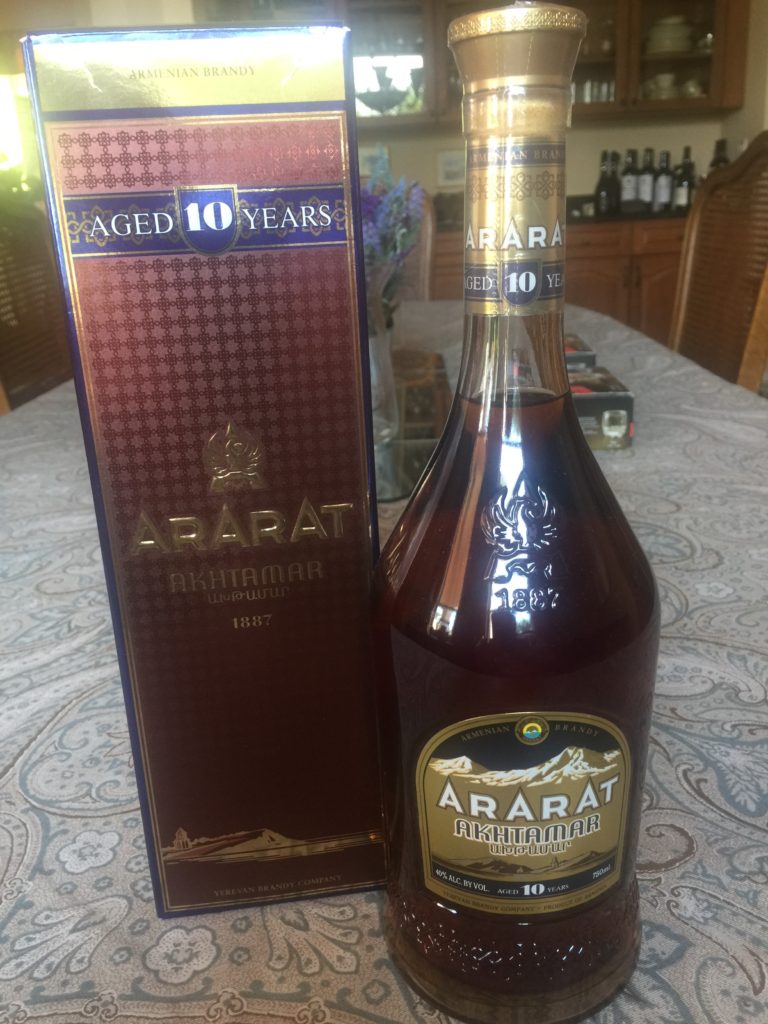
ArArAt Akhtmar, 10 year old, 40% ABV, Yerevan Brandy Company
Yerevan Brandy Company was founded in 1887 and is the leading producer of brandy in Armenia. Previously owned by the government, it was purchased by the French Pernod Ricard company in 1999 for $30 million. The products are labeled and marketed as “ArArAt”. ArArAt brandy is made from grapes of the Ararat plain, Tavush region and Nagorno-Karabakh. A new standard was introduced in 1999 that rigidly regulates Armenian Cognac production. Yerevan Brandy Company produces a variety of ArArAt brandies under a number of brands – Erebuni, Nairi, Tonakan, Akhtamar, Otborny, Ani, Dvia and Armenia – ranging from 3 to 30 years old.
According to the company tasting notes, this is what we expect to find when tasting the ArArAt Ahktmar 10 year old: “The color is a rich mahogany. On the nose, there is a distinctive dried dark fruit sweetness, followed by exotic tropical spices with notes of vanilla and butterscotch. On the palate, the brandy has a rich, creamy texture with notes of raisins, figs, apricots and a hint of pear. The finish is long, with dried fruit sweetness and cinnamon notes along with a bit of toasted oak.” It should remind us more of a Spanish brandy than French Cognac.
Why Armenia?
I am sure you are wondering why in the world do I have such an interest in wines from a country on the other side of the world that many people have never even heard of, let alone tasted the wines. And that is a really good question!
If you have followed any of my previous articles, you would have noticed that we have researched several countries/wine regions that are unfamiliar to the majority of casual wine drinkers. A number of years back we discovered the world of “Exotic Wine Travel”. Matthew Horkey and Charine Tan are two winelovers who did more than just try to find unfamiliar wines on the internet – they actually travelled to those countries, some quite extensively, and immersed themselves in the culture, the geography, people, food and most of all, their wines! In 2015 they established “Exotic Wine Travel” and in 2015 and 2016 toured the countries of Turkey, Armenia and Georgia. They wrote their first wine travel book called “Uncorking the Caucasus: Wines from Turkey, Armenia and Georgia”. You can find that one and their other wine travel books on Amazon.com and become fascinated by their wine travels and tasting just like I did. Since then – thanks to reading their books, watching their social media posts and You Tube videos, I have worked passionately to find some wines from these more “exotic” places like Turkey, Georgia, Croatia, Slovenia, and Hungary. We did find wines from all of these countries plus some others, and even more importantly – we actually got to drink them!
Up until recently, Armenia was not part of that list of accomplishments. Just a few months ago while being under COVID-19 “shelter-in-place”, I had plenty of time to watch Facebook Live and You Tube interviews and watched Matthew and Charine interview the owners of Karas and Zorah Wineries. I really enjoyed “meeting” them so far away around the world and so wanted to taste their wines. The rest is forkandcorkdivine history. Not only did I find some wines on the internet, but I purchased them, actually received them, and started on plans to serve them along with some typical Armenian foods. I have yet to taste these wines at the time of writing this article, but that is about to change very soon. I’ve also spent many days researching the food traditionally served in Armenia, learning what should pair best with my selection of Armenian wines, and find recipes and ingredients that I can prepare. You can expect to hear about and see pictures of Armenian foods like Armenian String Cheese, Bastirma, EECH, Lahmajoon, Shish Kebab, Armenian Rice Pilaf and Rolled Eggplant Salad. And of course the wines that were highlighted in this article. You will have to check back to our website soon to see that post! I know I can’t wait!!
The future of Armenian wines
Winemaking may have been around for over 6,000 years but quality wine has just been produced here during the last decade or less. The country is very old, but in most respects it is very young. It has not been possible to utilize modern winemaking techniques until quite recently when Armenians who left the country years ago, have returned bringing with them money, marketing skills, connections and the desire to showcase some ancient traditions and put Armenia on the winemaking map. Up until now if you asked anyone what kind of “spirits” came from Armenia, they would tell you “brandy”. There is still plenty of brandy made in Armenia, and it is high quality, but the real excitement is to see what is on the horizon for the Armenian wine industry. Areni Noir may just become the new wine sensation! Some of Armenia’s up-and-coming winemakers and winery owners predict that this will be a totally different winemaking region within the next ten years, and Armenia will take its rightful place in the global wine market. We hope that is true. We will be watching.
I have spent quite a bit of my time researching about this topic, but I have to point out that there is not a lot of information available. The information I did use came from “Uncorking the Caucasus: Wines from Turkey, Armenia and Georgia” by Charine Tan and Matthew Horkey plus numerous internet articles and resources. I do try my best to use correct information, and apologize if I have mentioned anything in error. I am always willing to make corrections when presented updated information.
On to our next wine adventure! Cheers.
Forkandcorkdivine.com
6.3.2020

